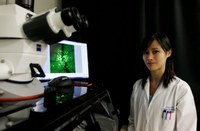
Dr Choi-Fong Cho
Position:
- Post-Doctoral Fellow, Department of Oncology, University of Alberta
Biography:
Dr Cho is a post-doctoral fellow at the University of Alberta (Department of Oncology), and will be assuming a new post-doctoral position at the Brigham and Women's Hospital, Harvard Medical School (Department of Neurosurgery) in January 2014.
Dr Cho received her PhD in January 2013 at the University of Western Ontario (Department of Medical Biophysics). Her research focused mainly on non-invasive targeting of cancer to facilitate early diagnosis and directed therapeutics.
During the early stages of her PhD, Dr Cho focused her efforts on developing new strategies to screen one-bead-one-compound (OBOC) peptide libraries to enable rapid and accurate identification of novel affinity peptide ligands against specific cancer biomarkers.
In addition to screening against purified protein, Dr Cho has also designed a high throughput approach to efficiently identify novel affinity ligands from screening OBOC libraries against live cells.
Together with Dr John Lewis (Dept of Oncology, University of Alberta) and Dr Leonard Luyt (Dept of Chemistry, University of Western Ontario), Dr Cho used the screening approaches described above to discover several peptides with high binding affinity for an angiogenesis marker, a protein known as EGFL7.
They showed that fluorescent peptides were taken up and retained by cancer cells expressing the target protein on their cellular surface compared to control peptides. These peptides were incorporated onto fluorescent viral nanoparticles for applications in fluorescence microscopy and drug delivery (in collaboration with the laboratory of Dr Steinmetz at Case Western Reserve University).
Dr Cho demonstrated that EGFL7-targeted nanoparticles exhibited higher accumulation in fibrosarcoma tumors and their blood vessels compared to control nanoparticles using xenograft tumor models in both mice and chicken embryos. These peptides could serve as promising diagnostic tools for non-invasive detection of early cancer development.
Best publications:
- Discovery of novel integrin ligands from combinatorial libraries using a multiplex "beads on a bead" approach. Cho CF, Amadei GA, Breadner D, Luyt LG, Lewis JD. Nano Lett. 2012 Nov 14;12(11):5957-65
- Synthesis, radiometal labeling and in vitro evaluation of a targeted PPIX derivative. Azad BB, Cho CF, Lewis JD, Luyt LG. Appl Radiat Isot. 2012 Mar;70(3):505-11.
- Evaluation of nanoparticle uptake in tumors in real time using intravital imaging.Cho CF, Ablack A, Leong HS, Zijlstra A, Lewis J. J Vis Exp. 2011 Jun 21;(52)
- Cowpea mosaic virus nanoparticles target surface vimentin on cancer cells. Steinmetz NF, Cho CF, Ablack A, Lewis JD, Manchester M. Nanomedicine. 2011 Feb;6(2):351-64.
- A fast, reproducible and low-cost method for sequence deconvolution of 'on-bead' peptides via 'on-target' maldi-TOF/TOF mass spectrometry.Amadei GA, Cho CF, Lewis JD, Luyt LG. J Mass Spectrom. 2010 Mar;45(3):241-51.
One-bead-one-compound (OBOC) library, CPMV viral nanoparticle, Peptide, EGFL7 protein, Angiogenesis, Imaging tumor vasculature.


